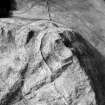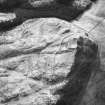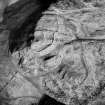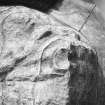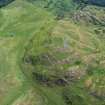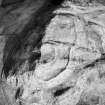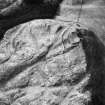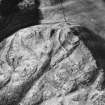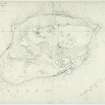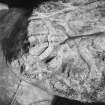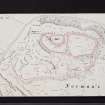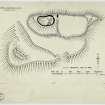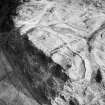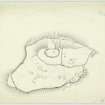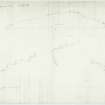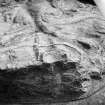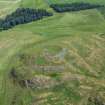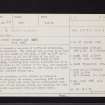Scheduled Maintenance
Please be advised that this website will undergo scheduled maintenance on the following dates: •
Tuesday 3rd December 11:00-15:00
During these times, some services may be temporarily unavailable. We apologise for any inconvenience this may cause.
Norman's Law
Fort (Iron Age), Settlement (Period Unassigned)
Site Name Norman's Law
Classification Fort (Iron Age), Settlement (Period Unassigned)
Canmore ID 31814
Site Number NO32SW 22
NGR NO 3053 2019
Datum OSGB36 - NGR
Permalink http://canmore.org.uk/site/31814
- Council Fife
- Parish Dunbog
- Former Region Fife
- Former District North East Fife
- Former County Fife
NO32SW 22.00 3053 2019
(NO 3053 2019) Norman's Law (NAT)
Fort (NR)
OS 6" map (1959).
NO32SW 22.01 NO 305 201 Jet Armlet
This fort reveals a sequence of different structures, some well preserved. The earliest are a heavy stone wall encircling the summit of the hill, c.700' by 250' and a wall which takes in all the SW foot of the hill to enclose an area which measures 1000' NE-SW by 550' transversely, including that already described but it is not known which is the earlier of the two. The contours of the hill suggest the former is more likely, but there is no real evidence either way.
The latest structure in the citadel or defensive enclosure occupying the summit, measuring 170' by 100' within a 12' thick wall which may be contemporary with the numbers of hut circles within and overlying the fort walls locally associated with late Roman times.
RCAHMS 1933; RCAHMS TS 1954; R W Feachem 1963; R W Feachem 1966.
A fort and settlement. generally as described. The majority of the internal features shown on the RCAHMS plan of 1954 are still identifiable, and additional huts and walls have been located.
Surveyed at 1/2500.
Visited by OS (JLD) 31 October 1956 and (JP) 29 June 1970.
Figs (RCAHMS Inv) : Plan.
Field Visit (19 May 1926)
Fort, Norman's Law.
Occupying the summit of the hill at an elevation of 936 feet above sea-level, this fort, despite its great size, does not exhibit the complexity or constructive skill that is so conspicuously in evidence on other large fortified sites in the county, such as Clatchard Craig (NO21NW 18), and the East Lomond (NO20NW 20). It is nevertheless remarkable for the extent and strength of its walled defences, which have been well adapted to the broken and rugged character of the hill-side. The name "Dun-more" or "the great fort," frequently applied to it, is well deserved. In common with many other prehistoric structures in the county, it has been much destroyed and the walls are scattered to the foundations, except for a mere fragment, showing only two courses, which remains at the north-east corner. The enclosure, which is kidney-shaped, lies with its major axis almost due east and west, and measures approximately 180 by 100 feet. It has been protected by a massive wall, varying in thickness from an average of 9 or 10 feet to a maximum of 16 feet at the entrance, which is at the north-east corner and is 10 feet wide. The ground within is broken and uneven, inclining sharply downwards to the south and east, where there is a somewhat sheltered hollow, covered with indefinite remains and debris, which according to Small was the position of a well (1).
Reference to the plan will show that, except on the north, where its wall follows the natural contour of a steep and rocky scarp rising abruptly from lands now under cultivation, the main fort is completely surrounded by a second enclosure, of which it might almost be regarded as the citadel. Like the main fort itself, this second enclosure is entered close to its northeast corner, where the continuity of the surrounding wall is broken by a gap 15 feet wide. Adjoining it on the east is a third and slightly larger enclosure, which can best be described as an annexe. It is entered at the south-west corner and is without artificial protection on the north except at the eastern extremity, where there is a short return of the wall that bounds it on the east and south. Outside of the whole is yet another wall, which seems to start near the north-east corner of the plateau, but stops abruptly after making a rapid approach to the wall of the annexe. Resuming its course 150 feet farther on, it sweeps southwards, westwards (with a gap of 20 feet for entrance), and finally northwards until it is lost against the face of a rocky hillock. The enclosure which it. forms is thus incomplete, but it is considerably larger than the second and third taken together. It should be added that all of the walls, except those of the main fort, are in such a ruinous condition that it is impossible to determine their details with precision. It cannot even be said with any confidence that they were contemporaneous.
RCAHMS 1933, visited 19 May 1926.
Cf. Interesting Roman Antiquities of Fife, p.231.
Field Visit (17 June 1954)
This site was included within the RCAHMS Marginal Land Survey (1950-1962), an unpublished rescue project. Site descriptions, organised by county, are available to view online - see the searchable PDF in 'Digital Items'. These vary from short notes, to lengthy and full descriptions. Contemporary plane-table surveys and inked drawings, where available, can be viewed online in most cases - see 'Digital Images'. The original typecripts, notebooks and drawings can also be viewed in the RCAHMS search room.
Information from RCAHMS (GFG) 19 July 2013.
Publication Account (1987)
The rocky summit of Norman's Law, commanding extensive views in all directions, has formed the natural focus for a series of defensive enclosures of several phases. The earlier phases may be indicated by the walls that take in the summit area (some 220 m by 75 m) and the lower terraces to the south, while the later phase of defence is probably the small fort on the summit, which measures about 50 m by 30 m within a wall up to 5m in thickness with inner and outer facing-stones visible.
There are the traces of many round stone-walled houses on the summit and on the lower terraces, some of them associated with small enclosures, several of which appear to be later than the periods of fortification.
Information from ‘Exploring Scotland’s Heritage: Fife and Tayside’, (1987).
Note (22 June 2015 - 18 October 2016)
A complex fort occupies the upper slopes and summit of Norman's Law, commanding spectacular views N and W across the Firth of Tay. It comprises no fewer than four separate enclosures, the innermost being an oval enclosure on the summit measuring some 53m from E to W by 29m transversely (0.13ha) within a wall about 3.6m in thickness; a single hut-circle lies adjacent to an area of paving within the E end of the interior and a stone-filled hollow at the rear of the wall on the SE was probably a well (Small 1823, 231). The entrance is on the ENE. At the time that RCAHMS investigators drew up a plan in 1954 for the Survey of Marginal Lands, they were unable to determine the precise relationship between this inner work and the enclosure that surrounds it, suggesting that the wall of the outer, which on the NW turns inwards to meet the inner at right-angles, either abutted it or was bonded into it. Richard Feachem asserted subsequently that the inner enclosure almost certainly overlay the outer wall (1963, 125), though this assertion is probably based on his model of early medieval citadel forts rather than an observation of the field evidence here on Norman's Law. This second enclosure, termed the Western Enclosure in the RCAHMS description of 1954, measures about 100m from E to W by 65m transversely (0.52ha) and is bounded by a wall about 3.5m in thickness, but this, on plan at least, appears to be a subdivision of a larger enclosure taking in the whole of the summit area, and measuring internally a maximum of 215m from E to W by 75m transversely (1.22ha). The entrance into this larger enclosure is midway along the S side and gave access into the E half of the interior, which in the RCAHMS description of 1954 is termed the Eastern Enclosure and was regarded as an annexe to the Western Enclosure, largely because the E half occupies a lower less defensible terrace. They supported this interpretation with the observation that the only entrance into the Western Enclosure was from the E half at the N end of the common wall that separated them. In truth the relationship of the common wall that separates the two halves of this larger enclosure to the wall forming its S side is unknown, and the configuration of these defences may be reconstructed in several different ways; though again Feachem believed they included the remains of a single large fort. Likewise the relationship to the outermost defences to these inner enclosures is not known, its wall following natural terraces around the flanks of the hill to enclose an area measuring 350m from ENE to WSW by 190m transversely (5ha). A well-formed entrance is visible on the S, from which an engineered trackway mounts the slope to the entrance into the large summit enclosure. To the E of the entrance there are a series of enclosures and hut-circles overlying the ruins of the wall, apparently representing a later unenclosed settlement; the status of the rest of the ten hut-circles lying within the interior, and another five in the Eastern Enclosure, is less certain; several small rectangular footings are also visible immediately within the outer entrance and the Eastern Enclosure.
Information from An Atlas of Hillforts of Great Britain and Ireland – 18 October 2016. Atlas of Hillforts SC3144
Excavation (24 May 2022 - 26 May 2022)
NO 3053 2019 In Spring 2021 as part of a project assessing a series of ‘nuclear’ hillforts excavations were conducted at Norman’s Law hillfort in Fife in May 2022. Norman’s Law, identified by Feachem (1963) as a classic hillfort of this type, has outworks looping out from a central citadel and comprises up to eight enclosures encompassing a footprint of around 6.4ha.
Three trenches were excavated – one at the rampart of the central citadel, one at the wallface of an innermost enclosure and one on an outer enclosure wall. The central citadel trench showed very deep deposits that could not be bottomed due to dangers with the stability and depth of the deposits. Extensive wall collapse comprising large boulders and slabs were identified and found to conceal a very fragmented wall line with no obvious wallface surviving. Below were various layers of collapse with charcoal and bone throughout. Samples were retrieved from the collapse deposits for dating. In the upper collapse of the central citadel trench, an iron spearhead was located and in lower deposits hand- made pottery, slag and animal bone were recovered. Trench 2 targeted the innermost enclosure wall showing up to 1.2m of surviving deposits against a poorly constructed wallface. A thin occupation lens was found on bedrock and charcoal was found throughout collapse deposits above. A fragment of a jet ring was the only find. Trench 3 targeting an outer enclosure wall again found a poorly constructed/surviving wallface with collapse deposits up to 0.6m deep occurring over a thin occupation deposit/old ground surface found directly on the bedrock. Samples for dating were retrieved from all three trenches and post-excavation will establish an outline chronology for the deposits revealed.
Archive: University of Aberdeen and NRHE (intended)
Funder: University of Aberdeen
Gordon Noble, James O’Driscoll and Edouard Masson- Maclean – University of Aberdeen
(Source: DES Volume 23)
































